Brain–Computer Interface Speller Based on Steady-State Visual Evoked Potential: A Review Focusing on the Stimulus Paradigm and Performance
Abstract
1. Introduction
2. BCI Speller Based on SSVEP
2.1. System Architecture and Process
2.2. SSVEP Acquisition
2.3. SSVEP Detection Methods
2.4. Performance Evaluation
3. SSVEP-Based BCI Spellers
3.1. Bremen Speller
3.2. Multi-Stage SSVEP Speller
3.3. One-Stage SSVEP Speller
3.3.1. QWERTY Paradigm
3.3.2. RC Paradigm
3.3.3. Frequency–Phase Hybrid Coding (FPHC) Paradigm
3.4. Specific Paradigms
3.5. High-Frequency Stimuli-Based SSVEP Speller
4. SSVEP-Based Hybrid BCI Spellers
4.1. SSVEP-P300 Speller
4.2. SSVEP-ET Speller
4.3. SSVEP-EOG Speller
4.4. SSVEP-EMG Speller
5. Factors Influencing Performance and Visual Fatigue
6. Trends, Challenges, Prospective Directions, and Suggestions
6.1. Development Trends
6.2. Outstanding Challenges
6.2.1. Lack of Comparison of Paradigms
6.2.2. Lack of Research on System-Independent Factors Influencing Results
6.2.3. Lack of Research on Visual Fatigue
6.3. Directions for Future Research
6.4. Suggestions for Improvements
- i.
- Adding known effective and compatible auxiliary triggering methods;
- ii.
- Adding or improving the word prediction function;
- iii.
- Using advanced methods of SSVEP detection, such as the TRCA;
- iv.
- Adjusting the experimental environment to avoid system-independent interference, and
- v.
- Optimizing methods of calibration to select better parameters for subjects.
7. Conclusions
Author Contributions
Funding
Institutional Review Board Statement
Informed Consent Statement
Data Availability Statement
Conflicts of Interest
References
- Wolpaw, J.R.; Birbaumer, N.; Heetderks, W.J.; McFarland, D.J.; Peckham, P.H.; Schalk, G.; Donchin, E.; Quatrano, L.A.; Robinson, C.J.; Vaughan, T.M. Brain-computer interface technology: A review of the first international meeting. IEEE Trans. Rehabil. Eng. 2000, 8, 164–173. [Google Scholar] [CrossRef]
- Farwell, L.; Donchin, E. Talking off the top of your head: Toward a mental prosthesis utilizing event-related brain potentials. Electroencephalogr. Clin. Neurophysiol. 1988, 70, 510–523. [Google Scholar] [CrossRef]
- Hill, N.J.; Lal, T.N.; Bierig, K.; Birbaumer, N.; Schölkopf, B. An auditory paradigm for brain-computer interfaces. In Advances in Neural Information Processing Systems; NIPS Foundation: Vancouver, BC, Canada, 2005; pp. 569–576. [Google Scholar]
- Brouwer, A.-M. A tactile P300 brain-computer interface. Front. Neurosci. 2010, 4, 19. [Google Scholar] [CrossRef] [PubMed]
- Yue, J.; Jiang, J.; Zhou, Z.; Hu, D. SMR-Speller: A novel Brain-Computer Interface spell paradigm. In Proceedings of the 2011 3rd International Conference on Computer Research and Development, Shanghai, China, 11–13 March 2011; IEEE: New York, NY, USA, 2011; Volume 3, pp. 187–190. [Google Scholar]
- Li, Y.; Pan, J.; Wang, F.; Yu, Z. A Hybrid BCI System Combining P300 and SSVEP and Its Application to Wheelchair Control. IEEE Trans. Biomed. Eng. 2013, 60, 3156–3166. [Google Scholar] [CrossRef] [PubMed]
- Chen, X.; Zhao, B.; Wang, Y.; Gao, X. Combination of high-frequency SSVEP-based BCI and computer vision for controlling a robotic arm. J. Neural Eng. 2019, 16, 26012. [Google Scholar] [CrossRef] [PubMed]
- Zheng, X.; Xu, G.; Zhang, Y.; Liang, R.; Zhang, K.; Du, Y.; Xie, J.; Zhang, S. Anti-fatigue Performance in SSVEP-Based Visual Acuity Assessment: A Comparison of Six Stimulus Paradigms. Front. Hum. Neurosci. 2020, 14, 301. [Google Scholar] [CrossRef] [PubMed]
- Combaz, A.; Chatelle, C.; Robben, A.; Vanhoof, G.; Goeleven, A.; Thijs, V.; Van Hulle, M.M.; Laureys, S. A Comparison of Two Spelling Brain-Computer Interfaces Based on Visual P3 and SSVEP in Locked-In Syndrome. PLoS ONE 2013, 8, e73691. [Google Scholar] [CrossRef] [PubMed]
- Volosyak, I.; Guger, C.; Gräser, A. Toward BCI Wizard—best BCI approach for each user. In Proceedings of the 2010 Annual International Conference of the IEEE Engineering in Medicine and Biology, Buenos Aires, Argentina, 31 August–4 September 2010; IEEE: New York, NY, USA, 2010; pp. 4201–4204. [Google Scholar]
- Guo, F.; Hong, B.; Gao, X.; Gao, S. A brain–computer interface using motion-onset visual evoked potential. J. Neural Eng. 2008, 5, 477–485. [Google Scholar] [CrossRef]
- Hong, B.; Guo, F.; Liu, T.; Gao, X.; Gao, S. N200-speller using motion-onset visual response. Clin. Neurophysiol. 2009, 120, 1658–1666. [Google Scholar] [CrossRef]
- Liu, D.; Liu, C.; Hong, B. Bi-directional Visual Motion Based BCI Speller. In Proceedings of the 2019 9th International IEEE/EMBS Conference on Neural Engineering (NER), San Francisco, CA, USA, 20–23 March 2019; IEEE: New York, NY, USA, 2019; pp. 589–592. [Google Scholar]
- Nezamfar, H.; Salehi, S.S.M.; Moghadamfalahi, M.; Erdogmus, D. FlashType TM: A Context-Aware c-VEP-Based BCI Typing Interface Using EEG Signals. IEEE J. Sel. Top. Signal Process. 2016, 10, 932–941. [Google Scholar] [CrossRef]
- Blankertz, B.; Dornhege, G.; Krauledat, M.; Tangermann, M.; Williamson, J.; Murray-Smith, R.; Müller, K.-R. The Berlin brain-computer interface presents the novel mental typewriter Hex-O-Spell. Clin. Neurophysiol. 2006, 113, 108–109. [Google Scholar]
- Cao, L.; Xia, B.; Maysam, O.; Li, J.; Xie, H.; Birbaumer, N. A Synchronous Motor Imagery Based Neural Physiological Paradigm for Brain Computer Interface Speller. Front. Hum. Neurosci. 2017, 11, 274. [Google Scholar] [CrossRef]
- D’Albis, T.; Blatt, R.; Tedesco, R.; Sbattella, L.; Matteucci, M. A predictive speller controlled by a brain-computer interface based on motor imagery. ACM Trans. Comput. Interact. 2012, 19, 1–25. [Google Scholar] [CrossRef]
- Gembler, F.; Stawicki, P.; Saboor, A.; Volosyak, I. Dynamic time window mechanism for time synchronous VEP-based BCIs—Performance evaluation with a dictionary-supported BCI speller employing SSVEP and c-VEP. PLoS ONE 2019, 14, e0218177. [Google Scholar] [CrossRef]
- Edelman, B.J.; Meng, J.; Suma, D.; Zurn, C.; Nagarajan, E.; Baxter, B.S.; Cline, C.C.; He, B. Noninvasive neuroimaging enhances continuous neural tracking for robotic device control. Sci. Robot. 2019, 4, eaaw6844. [Google Scholar] [CrossRef]
- Suefusa, K.; Tanaka, T. A comparison study of visually stimulated brain–computer and eye-tracking interfaces. J. Neural Eng. 2017, 14, 36009. [Google Scholar] [CrossRef]
- Rezeika, A.; Benda, M.; Stawicki, P.; Gembler, F.; Saboor, A.; Volosyak, I. Brain–Computer Interface Spellers: A Review. Brain Sci. 2018, 8, 57. [Google Scholar] [CrossRef]
- Lotte, F.; Bougrain, L.; Cichocki, A.; Clerc, M.; Congedo, M.; Rakotomamonjy, A.; Yger, F. A review of classification algorithms for EEG-based brain–computer interfaces: A 10 year update. J. Neural Eng. 2018, 15, 31005. [Google Scholar] [CrossRef]
- Zhang, Y.; Xie, S.Q.; Wang, H.; Zhang, Z. Data Analytics in Steady-State Visual Evoked Potential-Based Brain–Computer Interface: A Review. IEEE Sens. J. 2021, 21, 1124–1138. [Google Scholar] [CrossRef]
- Mora-Cortes, A.; Manyakov, N.V.; Chumerin, N.; Van Hulle, M.M. Language Model Applications to Spelling with Brain-Computer Interfaces. Sensors 2014, 14, 5967–5993. [Google Scholar] [CrossRef]
- Schalk, G.; McFarland, D.J.; Hinterberger, T.; Birbaumer, N.; Wolpaw, J.R. BCI2000: A General-Purpose Brain-Computer Interface (BCI) System. IEEE Trans. Biomed. Eng. 2004, 51, 1034–1043. [Google Scholar] [CrossRef] [PubMed]
- Benda, M.; Stawicki, P.; Gembler, F.; Grichnik, R.; Rezeika, A.; Saboor, A.; Volosyak, I. Different Feedback Methods For An SSVEP-Based BCI. In Proceedings of the 2018 40th Annual International Conference of the IEEE Engineering in Medicine and Biology Society (EMBC), Honolulu, HI, USA, 18–21 July 2018; IEEE: New York, NY, USA, 2018; Volume 2018, pp. 1939–1943. [Google Scholar]
- Benda, M.; Volosyak, I. Comparison of Different Visual Feedback Methods for SSVEP-Based BCIs. Brain Sci. 2020, 10, 240. [Google Scholar] [CrossRef]
- Yamaguchi, T.; Omori, K.; Irie, J.; Inoue, K. Feature extraction from EEG signals in SSVEP spelling system. In Proceedings of the Proceedings of SICE Annual Conference 2010, Taipei, Taiwan, 18–21 August 2010; IEEE: New York, NY, USA, 2010; pp. 58–62. [Google Scholar]
- Nguyen, T.-H.; Chung, W.-Y. A Single-Channel SSVEP-Based BCI Speller Using Deep Learning. IEEE Access 2018, 7, 1752–1763. [Google Scholar] [CrossRef]
- Wang, Y.-T.; Nakanishi, M.; Wang, Y.; Wei, C.-S.; Cheng, C.-K.; Jung, T.-P. An Online Brain-Computer Interface Based on SSVEPs Measured From Non-Hair-Bearing Areas. IEEE Trans. Neural Syst. Rehabilitation Eng. 2017, 25, 14–21. [Google Scholar] [CrossRef] [PubMed]
- Cheng, M.; Gao, X.; Gao, S.; Xu, D. Design and implementation of a brain-computer interface with high transfer rates. IEEE Trans. Biomed. Eng. 2002, 49, 1181–1186. [Google Scholar] [CrossRef]
- Wang, Y.; Wang, R.; Gao, X.; Hong, B.; Gao, S. A Practical VEP-Based Brain–Computer Interface. IEEE Trans. Neural Syst. Rehabil. Eng. 2006, 14, 234–240. [Google Scholar] [CrossRef] [PubMed]
- Parini, S.; Maggi, L.; Turconi, A.C.; Andreoni, G. A Robust and Self-Paced BCI System Based on a Four Class SSVEP Paradigm: Algorithms and Protocols for a High-Transfer-Rate Direct Brain Communication. Comput. Intell. Neurosci. 2009, 2009, 1–11. [Google Scholar] [CrossRef]
- Friman, O.; Volosyak, I.; Graser, A. Multiple Channel Detection of Steady-State Visual Evoked Potentials for Brain-Computer Interfaces. IEEE Trans. Biomed. Eng. 2007, 54, 742–750. [Google Scholar] [CrossRef]
- Lin, Z.; Zhang, C.; Wu, W.; Gao, X. Frequency Recognition Based on Canonical Correlation Analysis for SSVEP-Based BCIs. IEEE Trans. Biomed. Eng. 2006, 53, 2610–2614. [Google Scholar] [CrossRef]
- Sagahon-Azua, J.; Tovar-Corona, B.; Zuniga-Valladares, J.A. Comparison between the Canonical Correlation Analysis and the Support Vector Machines as classification algorithms in an SSVEP-based Brain-Computer Interface. In Proceedings of the 2017 14th International Conference on Electrical Engineering, Computing Science and Automatic Control (CCE) 2017, Mexico City, Mexico, 20–22 October 2017; IEEE: New York, NY, USA, 2017; pp. 1–6. [Google Scholar]
- Zhang, Y.; Xu, P.; Cheng, K.; Yao, D. Multivariate synchronization index for frequency recognition of SSVEP-based brain–computer interface. J. Neurosci. Methods 2014, 221, 32–40. [Google Scholar] [CrossRef]
- Zhang, Y.; Zhou, G.; Jin, J.; Wang, X.; Cichocki, A. SSVEP recognition using common feature analysis in brain–computer interface. J. Neurosci. Methods 2015, 244, 8–15. [Google Scholar] [CrossRef]
- Zhang, Y.; Dong, L.; Zhang, R.; Yao, D.; Zhang, Y.; Xu, P. An Efficient Frequency Recognition Method Based on Likelihood Ratio Test for SSVEP-Based BCI. Comput. Math. Methods Med. 2014, 2014, 1–7. [Google Scholar] [CrossRef]
- Nakanishi, M.; Wang, Y.; Wang, Y.-T.; Jung, T.-P. A Comparison Study of Canonical Correlation Analysis Based Methods for Detecting Steady-State Visual Evoked Potentials. PLoS ONE 2015, 10, e0140703. [Google Scholar] [CrossRef]
- Poryzala, P.; Materka, A. Cluster analysis of CCA coefficients for robust detection of the asynchronous SSVEPs in brain–computer interfaces. Biomed. Signal Process. Control. 2014, 10, 201–208. [Google Scholar] [CrossRef]
- Pan, J.; Gao, X.; Duan, F.; Yan, Z.; Gao, S. Enhancing the classification accuracy of steady-state visual evoked potential-based brain–computer interfaces using phase constrained canonical correlation analysis. J. Neural Eng. 2011, 8, 36027. [Google Scholar] [CrossRef]
- Zhang, Y.; Zhou, G.; Zhao, Q.; Onishi, A.; Jin, J.; Wang, X.; Cichocki, A. Multiway Canonical Correlation Analysis for Frequency Components Recognition in SSVEP-Based BCIs. In Neural Information Processing, Part I; Lu, B.L., Zhang, L.Q., Kwok, J., Eds.; Springer: Berlin/Heidelberg, Germany, 2011; Volume 7062, pp. 287–295. [Google Scholar]
- Zhang, Y.; Zhou, G.; Jin, J.; Wang, M.; Wang, X.; Cichocki, A. L1-Regularized Multiway Canonical Correlation Analysis for SSVEP-Based BCI. IEEE Trans. Neural Syst. Rehabil. Eng. 2013, 21, 887–896. [Google Scholar] [CrossRef]
- Zhang, Y.; Zhou, G.; Jin, J.; Wang, X.; Cichocki, A. Frequency recognition in ssvep-based bci using multiset canonical correlation analysis. Int. J. Neural Syst. 2014, 24, 1450013. [Google Scholar] [CrossRef]
- Bin, G.; Gao, X.; Wang, Y.; Li, Y.; Hong, B.; Gao, S. A high-speed BCI based on code modulation VEP. J. Neural Eng. 2011, 8, 025015. [Google Scholar] [CrossRef]
- Nakanishi, M.; Wang, Y.; Wang, Y.-T.; Mitsukura, Y.; Jung, T.-P. A high-speed brain speller using steady-state visual evoked potentials. Int. J. Neural Syst. 2014, 24, 1450019. [Google Scholar] [CrossRef] [PubMed]
- Chen, X.; Wang, Y.; Gao, S.; Jung, T.-P.; Gao, X. Filter bank canonical correlation analysis for implementing a high-speed SSVEP-based brain–computer interface. J. Neural Eng. 2015, 12, 46008. [Google Scholar] [CrossRef]
- Chen, X.; Wang, Y.; Nakanishi, M.; Gao, X.; Jung, T.-P.; Gao, S. High-speed spelling with a noninvasive brain–computer interface. Proc. Natl. Acad. Sci. USA 2015, 112, E6058–E6067. [Google Scholar] [CrossRef] [PubMed]
- Nakanishi, M.; Wang, Y.; Chen, X.; Wang, Y.-T.; Gao, X.; Jung, T.-P. Enhancing Detection of SSVEPs for a High-Speed Brain Speller Using Task-Related Component Analysis. IEEE Trans. Biomed. Eng. 2018, 65, 104–112. [Google Scholar] [CrossRef] [PubMed]
- Lin, K.; Gao, S.; Gao, X. Boosting the information transfer rate of an SSVEP-BCI system using maximal-phase-locking value and minimal-distance spatial filter banks. Tsinghua Sci. Technol. 2019, 24, 262–270. [Google Scholar] [CrossRef]
- Podmore, J.J.; Breckon, T.P.; Aznan, N.K.N.; Connolly, J.D. On the Relative Contribution of Deep Convolutional Neural Networks for SSVEP-Based Bio-Signal Decoding in BCI Speller Applications. IEEE Trans. Neural Syst. Rehabil. Eng. 2019, 27, 611–618. [Google Scholar] [CrossRef]
- Wang, Y.; Chen, X.; Gao, X.; Gao, S. A Benchmark Dataset for SSVEP-Based Brain–Computer Interfaces. IEEE Trans. Neural Syst. Rehabil. Eng. 2017, 25, 1746–1752. [Google Scholar] [CrossRef]
- Nakanishi, M.; Wang, Y.-T.; Jung, T.-P. Transferring Shared Responses Across Electrode Montages for Facilitating Calibration in High-Speed Brain Spellers. In Proceedings of the 2018 40th Annual International Conference of the IEEE Engineering in Medicine and Biology Society (EMBC), Honolulu, HI, USA, 18–21 July 2018; Institute of Electrical and Electronics Engineers (IEEE): New York, NY, USA, 2018; pp. 89–92. [Google Scholar]
- Nakanishi, M.; Wang, Y.-T.; Wei, C.-S.; Chiang, K.-J.; Jung, T.-P. Facilitating Calibration in High-Speed BCI Spellers via Leveraging Cross-Device Shared Latent Responses. IEEE Trans. Biomed. Eng. 2020, 67, 1105–1113. [Google Scholar] [CrossRef]
- Wolpaw, J.; Ramoser, H.; McFarland, D.; Pfurtscheller, G. EEG-based communication: Improved accuracy by response verification. IEEE Trans. Rehabil. Eng. 1998, 6, 326–333. [Google Scholar] [CrossRef]
- Nykopp, T. Statistical Modelling Issues for the Adaptive Brain Interface. Master’s Thesis, Helsinki University of Technology, Department of Electrical and Communication Engineering, Espoo, Finland, 2001. [Google Scholar]
- Townsend, G.; LaPallo, B.; Boulay, C.; Krusienski, D.; Frye, G.; Hauser, C.; Schwartz, N.; Vaughan, T.; Wolpaw, J.; Sellers, E. A novel P300-based brain–computer interface stimulus presentation paradigm: Moving beyond rows and columns. Clin. Neurophysiol. 2010, 121, 1109–1120. [Google Scholar] [CrossRef]
- Akce, A.; Norton, J.J.S.; Bretl, T. An SSVEP-Based Brain–Computer Interface for Text Spelling With Adaptive Queries That Maximize Information Gain Rates. IEEE Trans. Neural Syst. Rehabil. Eng. 2014, 23, 857–866. [Google Scholar] [CrossRef]
- Volosyak, I.; Cecotti, H.; Valbuena, D.; Graser, A. Evaluation of the Bremen SSVEP based BCI in real world conditions. In Proceedings of the 2009 IEEE International Conference on Rehabilitation Robotics, Kyoto, Japan, 23–26 June 2009; IEEE: New York, NY, USA, 2009; Volume 1, pp. 322–331. [Google Scholar]
- Volosyak, I.; Moor, A.; Graeser, A. A Dictionary-Driven SSVEP Speller with a Modified Graphical User Interface. In Advances in Computational Intelligence, Part I; Cabestany, J., Rojas, I., Joya, G., Eds.; Springer: Berlin/Heidelberg, Germany, 2011; Volume 6691, pp. 353–361. [Google Scholar]
- Volosyak, I. SSVEP-based Bremen–BCI interface—boosting information transfer rates. J. Neural Eng. 2011, 8, 36020. [Google Scholar] [CrossRef]
- Kick, C.; Volosyak, I. Evaluation of different spelling layouts for SSVEP based BCIs. In Proceedings of the 2014 36th Annual International Conference of the IEEE Engineering in Medicine and Biology Society, Chicago, IL, USA, 26–30 August 2014; IEEE: New York, NY, USA, 2014; Volume 2014, pp. 1634–1637. [Google Scholar]
- Cecotti, H. A Self-Paced and Calibration-Less SSVEP-Based Brain–Computer Interface Speller. IEEE Trans. Neural Syst. Rehabil. Eng. 2010, 18, 127–133. [Google Scholar] [CrossRef] [PubMed]
- Saboor, A.; Gembler, F.; Benda, M.; Stawicki, P.; Rezeika, A.; Grichnik, R.; Volosyak, I. A Browser-Driven SSVEP-Based BCI Web Speller. In Proceedings of the 2018 IEEE International Conference on Systems, Man, and Cybernetics (SMC), Myazaki, Japan, 7–10 October 2018; IEEE: New York, NY, USA, 2018; pp. 625–630. [Google Scholar]
- Saboor, A.; Benda, M.; Gembler, F.; Volosyak, I. Word Prediction Support Model for SSVEP-Based BCI Web Speller. In Advances in Computational Intelligence, Part I; Rojas, I., Joya, G., Catala, A., Eds.; Springer: Berlin/Heidelberg, Germany, 2019; Volume 11506, pp. 430–441. [Google Scholar]
- Sadeghi, S.; Maleki, A. Character encoding based on occurrence probability enhances the performance of SSVEP-based BCI spellers. Biomed. Signal Process. Control. 2020, 58, 101888. [Google Scholar] [CrossRef]
- Cao, L.; Liu, T.; Hou, L.; Wang, Z.; Fan, C.; Li, J.; Wang, H. A Novel Real-Time Multi-Phase BCI Speller Based on Sliding Control Paradigm of SSVEP. IEEE Access 2019, 7, 133974–133981. [Google Scholar] [CrossRef]
- Hwang, H.-J.; Lim, J.-H.; Jung, Y.-J.; Choi, H.; Lee, S.W.; Im, C.-H. Development of an SSVEP-based BCI spelling system adopting a QWERTY-style LED keyboard. J. Neurosci. Methods 2012, 208, 59–65. [Google Scholar] [CrossRef] [PubMed]
- Yin, E.; Zhou, Z.; Jiang, J.; Yu, Y.; Hu, D. A Dynamically Optimized SSVEP Brain–Computer Interface (BCI) Speller. IEEE Trans. Biomed. Eng. 2014, 62, 1447–1456. [Google Scholar] [CrossRef]
- Chen, X.; Wang, Y.; Nakanishi, M.; Jung, T.-P.; Gao, X. Hybrid frequency and phase coding for a high-speed SSVEP-based BCI speller. In Proceedings of the 2014 36th Annual International Conference of the IEEE Engineering in Medicine and Biology Society, Chicago, IL, USA, 26–30 August 2014; IEEE: New York, NY, USA, 2014; pp. 3993–3996. [Google Scholar]
- Cao, T.; Wang, X.; Wang, B.; Wong, C.M.; Wan, F.; Mak, P.U.; Mak, P.I.; Vai, M.I. A high rate online SSVEP based brain-computer interface speller. In Proceedings of the 2011 5th International IEEE/EMBS Conference on Neural Engineering, Cancun, Mexico, 27 April–1 May 2011; IEEE: New York, NY, USA, 2011; pp. 465–468. [Google Scholar]
- Vilic, A.; Kjaer, T.W.; Thomsen, C.E.; Puthusserypady, S.; Sorensen, H.B.D. DTU BCI speller: An SSVEP-based spelling system with dictionary support. In Proceedings of the 2013 35th Annual International Conference of the IEEE Engineering in Medicine and Biology Society (EMBC), Osaka, Japan, 3–7 July 2013; IEEE: New York, NY, USA, 2013; Volume 2013, pp. 2212–2215. [Google Scholar]
- Sánchez, G.; Diez, P.F.; Avila, E.; Leber, E.L. Simple communication using a SSVEP-based BCI. J. Phys. Conf. Ser. 2011, 332, 012017. [Google Scholar] [CrossRef]
- Khatri, T.K.; Farooq, H. A Sentence Speller Based on SSVEP Brain Computing Interface Using EEG. In Proceedings of the 2019 2nd International Conference on Communication, Computing and Digital systems (C-CODE), Islamabad, Pakistan, 6–7 March 2019; IEEE: New York, NY, USA, 2019; pp. 220–225. [Google Scholar]
- Wang, Y.J.; Wang, R.P.; Gao, X.R.; Gao, S.K. Brain-computer interface based on the high-frequency steady-state visual evoked potential. In Proceedings of the 2005 First International Conference on Neural Interface and Control, Wuhan, China, 26–28 May 2005; IEEE: New York, NY, USA, 2005; pp. 37–39. [Google Scholar]
- Won, D.-O.; Zhang, H.H.; Guan, C.; Lee, S.-W. A BCI speller based on SSVEP using high frequency stimuli design. In Proceedings of the 2014 IEEE International Conference on Systems, Man, and Cybernetics (SMC), San Diego, CA, USA, 5–8 October 2014; IEEE: New York, NY, USA, 2014; pp. 1068–1071. [Google Scholar]
- Won, D.-O.; Hwang, H.-J.; Dähne, S.; Müller, K.-R.; Lee, S.-W. Effect of higher frequency on the classification of steady-state visual evoked potentials. J. Neural Eng. 2015, 13, 16014. [Google Scholar] [CrossRef]
- Chabuda, A.; Durka, P.; Zygierewicz, J. High Frequency SSVEP-BCI With Hardware Stimuli Control and Phase-Synchronized Comb Filter. IEEE Trans. Neural Syst. Rehabil. Eng. 2017, 26, 344–352. [Google Scholar] [CrossRef]
- Ajami, S.; Mahnam, A.; Abootalebi, V. Development of a practical high frequency brain–computer interface based on steady-state visual evoked potentials using a single channel of EEG. Biocybern. Biomed. Eng. 2018, 38, 106–114. [Google Scholar] [CrossRef]
- Lee, M.-H.; Williamson, J.; Lee, Y.-E.; Lee, S.-W. Mental fatigue in central-field and peripheral-field steady-state visually evoked potential and its effects on event-related potential responses. NeuroReport 2018, 29, 1301–1308. [Google Scholar] [CrossRef]
- Panicker, R.C.; Puthusserypady, S.; Sun, Y. An Asynchronous P300 BCI with SSVEP-Based Control State Detection. IEEE Trans. Biomed. Eng. 2011, 58, 1781–1788. [Google Scholar] [CrossRef]
- Vazquez, E.S.; Cagigal, V.M.; Gomez-Pilar, J.; Hornero, R. Asynchronous Control of ERP-Based BCI Spellers Using Steady-State Visual Evoked Potentials Elicited by Peripheral Stimuli. IEEE Trans. Neural Syst. Rehabil. Eng. 2019, 27, 1883–1892. [Google Scholar] [CrossRef]
- Yin, E.; Zhou, Z.; Jiang, J.; Chen, F.; Liu, Y.; Hu, D. A novel hybrid BCI speller based on the incorporation of SSVEP into the P300 paradigm. J. Neural Eng. 2013, 10, 26012. [Google Scholar] [CrossRef]
- Yin, E.; Zhou, Z.; Jiang, J.; Chen, F.; Liu, Y.; Hu, D. A Speedy Hybrid BCI Spelling Approach Combining P300 and SSVEP. IEEE Trans. Biomed. Eng. 2013, 61, 473–483. [Google Scholar] [CrossRef]
- Yin, E.; Zeyl, T.; Saab, R.; Chau, T.; Hu, D.; Zhou, Z. A Hybrid Brain–Computer Interface Based on the Fusion of P300 and SSVEP Scores. IEEE Trans. Neural Syst. Rehabil. Eng. 2015, 23, 693–701. [Google Scholar] [CrossRef]
- Xu, M.; Qi, H.; Wan, B.; Yin, T.; Liu, Z.; Ming, D. A hybrid BCI speller paradigm combining P300 potential and the SSVEP blocking feature. J. Neural Eng. 2013, 10, 26001. [Google Scholar] [CrossRef]
- Xu, M.; Qi, H.; Zhang, L.; Ming, D. The parallel-BCI speller based on the P300 and SSVEP features. In Proceedings of the 2013 6th International IEEE/EMBS Conference on Neural Engineering (NER), San Diego, CA, USA, 6–8 November 2013; IEEE: New York, NY, USA, 2013; pp. 1029–1032. [Google Scholar]
- Xu, M.; Chen, L.; Zhang, L.; Qi, H.; Ma, L.; Tang, J.; Wan, B.; Ming, D. A visual parallel-BCI speller based on the time–frequency coding strategy. J. Neural Eng. 2014, 11, 26014. [Google Scholar] [CrossRef]
- Chang, M.H.; Lee, J.S.; Heo, J.; Park, K.S. Eliciting dual-frequency SSVEP using a hybrid SSVEP-P300 BCI. J. Neurosci. Methods 2016, 258, 104–113. [Google Scholar] [CrossRef] [PubMed]
- Hwang, J.-Y.; Lee, M.-H.; Lee, S.-W. A brain-computer interface speller using peripheral stimulus-based SSVEP and P300. In Proceedings of the 2017 5th International Winter Conference on Brain-Computer Interface (BCI), Sabuk, Kenya, 9–11 January 2017; IEEE: New York, NY, USA, 2017; pp. 77–78. [Google Scholar]
- Pires, G.; Yasemin, M.; Nunes, U.J. Naturally embedded SSVEP phase tagging in a P300-based BCI: LSC-4Q speller*. In Proceedings of the 2019 IEEE International Conference on Systems, Man and Cybernetics (SMC), Bari, Italy, 6–9 October 2019; IEEE: New York, NY, USA, 2019; pp. 2748–2753. [Google Scholar]
- Loughnane, G.M.; Meade, E.; Reilly, R.B.; Lalor, E.C. Towards a gaze-independent hybrid-BCI based on SSVEPs, alpha-band modulations and the P300. In Proceedings of the 2014 36th Annual International Conference of the IEEE Engineering in Medicine and Biology Society, Chicago, IL, USA, 26–30 August 2014; IEEE: New York, NY, USA, 2014; Volume 2014, pp. 1322–1325. [Google Scholar]
- Jalilpour, S.; Sardouie, S.H.; Mijani, A. A novel hybrid BCI speller based on RSVP and SSVEP paradigm. Comput. Methods Programs Biomed. 2020, 187, 105326. [Google Scholar] [CrossRef]
- Hwang, H.-J.; Lim, J.-H.; Lee, J.-H.; Im, C.-H. Implementation of a mental spelling system based on steady-state visual evoked potential (SSVEP). In Proceedings of the2013 International Winter Workshop on Brain-Computer Interface (BCI), Gangwon, Korea, 18–20 February 2013; IEEE: New York, NY, USA, 2013; pp. 81–83. [Google Scholar]
- Lee, J.-H.; Lim, J.-H.; Hwang, H.-J.; Im, C.-H. Development of a hybrid mental speller combining EEG-based brain-computer interface and webcam-based eye-tracking. In Proceedings of the 2013 35th Annual International Conference of the IEEE Engineering in Medicine and Biology Society (EMBC), Osaka, Japan, 3–7 July 2013; IEEE: New York, NY, USA, 2013; pp. 2240–2242. [Google Scholar]
- Mannan, M.M.N.; Kamran, M.A.; Kang, S.; Choi, H.S.; Jeong, M.Y. A Hybrid Speller Design Using Eye Tracking and SSVEP Brain–Computer Interface. Sensors 2020, 20, 891. [Google Scholar] [CrossRef] [PubMed]
- Saravanakumar, D.; Reddy, R.M. A Novel Visual Keyboard System for Disabled People/Individuals using Hybrid SSVEP Based Brain Computer Interface. In Proceedings of the 2018 International Conference on Cyberworlds (CW), Singapore, 3–5 October 2018; IEEE: New York, NY, USA, 2013; pp. 264–269. [Google Scholar]
- Yao, Z.; Ma, X.; Wang, Y.; Zhang, X.; Liu, M.; Pei, W.; Chen, H. High-Speed Spelling in Virtual Reality with Sequential Hybrid BCIs. IEICE Trans. Inf. Syst. 2018, E101.D, 2859–2862. [Google Scholar] [CrossRef]
- Lin, X.; Chen, Z.; Xu, K.; Zhang, S. Development of a High-speed Mental Spelling System Combining Eye Tracking and SSVEP-based BCI with High Scalability. In Proceedings of the 2019 41st Annual International Conference of the IEEE Engineering in Medicine and Biology Society (EMBC), Berlin, Germany, 23–27 July 2019; IEEE: New York, NY, USA, 2019; pp. 6318–6322. [Google Scholar]
- Stawicki, P.; Gembler, F.; Rezeika, A.; Volosyak, I. A Novel Hybrid Mental Spelling Application Based on Eye Tracking and SSVEP-Based BCI. Brain Sci. 2017, 7, 35. [Google Scholar] [CrossRef]
- Saravanakumar, D.; Reddy, M.R. A high performance hybrid SSVEP based BCI speller system. Adv. Eng. Inform. 2019, 42, 100994. [Google Scholar] [CrossRef]
- Saravanakumar, D.; Reddy, M.R. A virtual speller system using SSVEP and electrooculogram. Adv. Eng. Inform. 2020, 44, 101059. [Google Scholar] [CrossRef]
- Lin, K.; Cinetto, A.; Wang, Y.; Chen, X.; Gao, S.; Gao, X. An online hybrid BCI system based on SSVEP and EMG. J. Neural Eng. 2016, 13, 26020. [Google Scholar] [CrossRef]
- Rezeika, A.; Benda, M.; Stawicki, P.; Gembler, F.; Saboor, A.; Volosyak, I. 30-Targets Hybrid BNCI Speller Based on SSVEP and EMG. In Proceedings of the 2018 IEEE International Conference on Systems, Man, and Cybernetics (SMC), Miyazaki, Japan, 7–10 October 2018; IEEE: New York, NY, USA, 2018; pp. 153–158. [Google Scholar]
- Segers, H.; Combaz, A.; Manyakov, N.; Chumerin, N.; Vanderperren, K.; Van Huffel, S.; Van Hulle, M.M. Steady State Visual Evoked Potential (SSVEP)—Based Brain Spelling System with Synchronous and Asynchronous Typing Modes. In Proceedings of the 15th Nordic-Baltic Conference on Biomedical Engineering and Medical Physics (NBC 2011), Aalborg, Denmark, 14–17 June 2011; Springer: Berlin/Heidelberg, Germany, 2011; Volume 34, pp. 164–167. [Google Scholar]
- Egembler, F.; Estawicki, P.; Evolosyak, I. Autonomous Parameter Adjustment for SSVEP-Based BCIs with a Novel BCI Wizard. Front. Neurosci. 2015, 9, 474. [Google Scholar] [CrossRef]
- Cecotti, H. Adaptive Time Segment Analysis for Steady-State Visual Evoked Potential Based Brain–Computer Interfaces. IEEE Trans. Neural Syst. Rehabil. Eng. 2020, 28, 552–560. [Google Scholar] [CrossRef]
- Gembler, F.; Stawicki, P.; Volosyak, I. Exploring the Possibilities and Limitations of Multitarget SSVEP-based BCI Applications. In Proceedings of the 2016 38th Annual International Conference of the IEEE Engineering in Medicine and Biology Society, Orlando, FL, USA, 16–20 August 2016; Patton, J., Barbieri, R., Ji, J., Jabbari, E., Dokos, S., Mukkamala, R., Guiraud, D., Jovanov, E., Dhaher, Y., Panescu, D., et al., Eds.; IEEE: New York, NY, USA, 2016; pp. 1488–1491. [Google Scholar]
- Kwak, N.-S.; Won, D.-O.; Kim, K.-T.; Park, H.-J.; Lee, S.-W. Analysis of steady state visual evoked potentials based on viewing distance changes for brain-machine interface speller. In Proceedings of the 2016 IEEE International Conference on Systems, Man, and Cybernetics (SMC), Budapest, Hungary, 9–12 October 2016; Institute of Electrical and Electronics Engineers (IEEE): New York, NY, USA, 2017; pp. 1502–1505. [Google Scholar]
- Psotta, L.; Rezeika, A.; Volosyak, I. Investigating the Influence of Background Music on the Performance of an SSVEP-based BCI. In Proceedings of the 2019 IEEE International Conference on Systems, Man and Cybernetics (SMC), Bari, Italy, 6–9 October 2019; Institute of Electrical and Electronics Engineers (IEEE): New York, NY, USA, 2019; pp. 4187–4193. [Google Scholar]
- Volosyak, I.; Gembler, F.; Stawicki, P. Age-related differences in SSVEP-based BCI performance. Neurocomputing 2017, 250, 57–64. [Google Scholar] [CrossRef]
- Gembler, F.; Stawicki, P.; Volosyak, I. A Comparison of SSVEP-Based BCI-Performance between Different Age Groups. In Advances in Computational Intelligence, Part I; Rojas, I., Joya, G., Catala, A., Eds.; Springer: Berlin/Heidelberg, Germany, 2015; Volume 9094, pp. 71–77. [Google Scholar]
- Tang, Z.; Wang, Y.; Dong, G.; Pei, W.; Chen, H. Learning to control an SSVEP-based BCI speller in naïve subjects. In Proceedings of the 2017 39th Annual International Conference of the IEEE Engineering in Medicine and Biology Society (EMBC), Jeju, Korea, 11–15 July 2017; Institute of Electrical and Electronics Engineers (IEEE): New York, NY, USA, 2017; pp. 1934–1937. [Google Scholar]
- Seno, B.D.; Matteucci, M.; Mainardi, L. Online Detection of P300 and Error Potentials in a BCI Speller. Comput. Intell. Neurosci. 2010, 2010, 1–5. [Google Scholar] [CrossRef]
- Schmidt, N.M.; Blankertz, B.; Treder, M.S. Online detection of error-related potentials boosts the performance of mental typewriters. BMC Neurosci. 2012, 13, 19. [Google Scholar] [CrossRef]
- Spüler, M.; Bensch, M.; Kleih, S.; Rosenstiel, W.; Bogdan, M.; Kübler, A. Online use of error-related potentials in healthy users and people with severe motor impairment increases performance of a P300-BCI. Clin. Neurophysiol. 2012, 123, 1328–1337. [Google Scholar] [CrossRef] [PubMed]
- Margaux, P.; Emmanuel, M.; Sébastien, D.; Olivier, B.; Jérémie, M. Objective and Subjective Evaluation of Online Error Correction during P300-Based Spelling. Adv. Hum.-Comput. Interact. 2012, 2012, 1–13. [Google Scholar] [CrossRef]
- Mainsah, B.O.; Morton, K.D.; Collins, L.M.; Sellers, E.W.; Throckmorton, C.S. Moving Away From Error-Related Potentials to Achieve Spelling Correction in P300 Spellers. IEEE Trans. Neural Syst. Rehabil. Eng. 2014, 23, 737–743. [Google Scholar] [CrossRef] [PubMed][Green Version]
- Gao, Z.; Zhang, K.; Dang, W.; Yang, Y.; Wang, Z.; Duan, H.; Chen, G. An adaptive optimal-Kernel time-frequency representation-based complex network method for characterizing fatigued behavior using the SSVEP-based BCI system. Knowl.-Based Syst. 2018, 152, 163–171. [Google Scholar] [CrossRef]
- Cao, T.; Wan, F.; Wong, C.M.; Da Cruz, J.N.; Hu, Y. Objective evaluation of fatigue by EEG spectral analysis in steady-state visual evoked potential-based brain-computer interfaces. Biomed. Eng. Online 2014, 13, 28. [Google Scholar] [CrossRef]
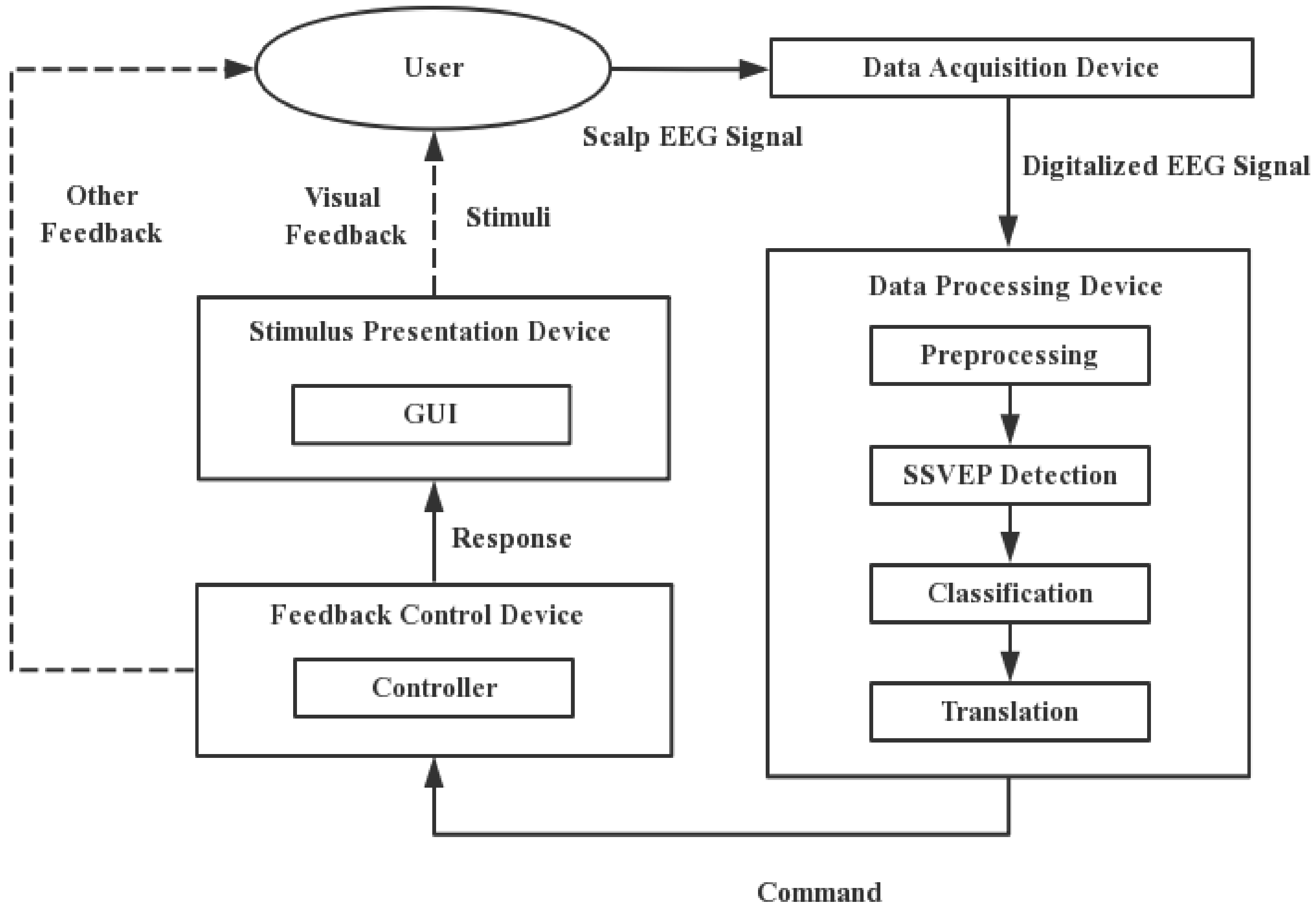
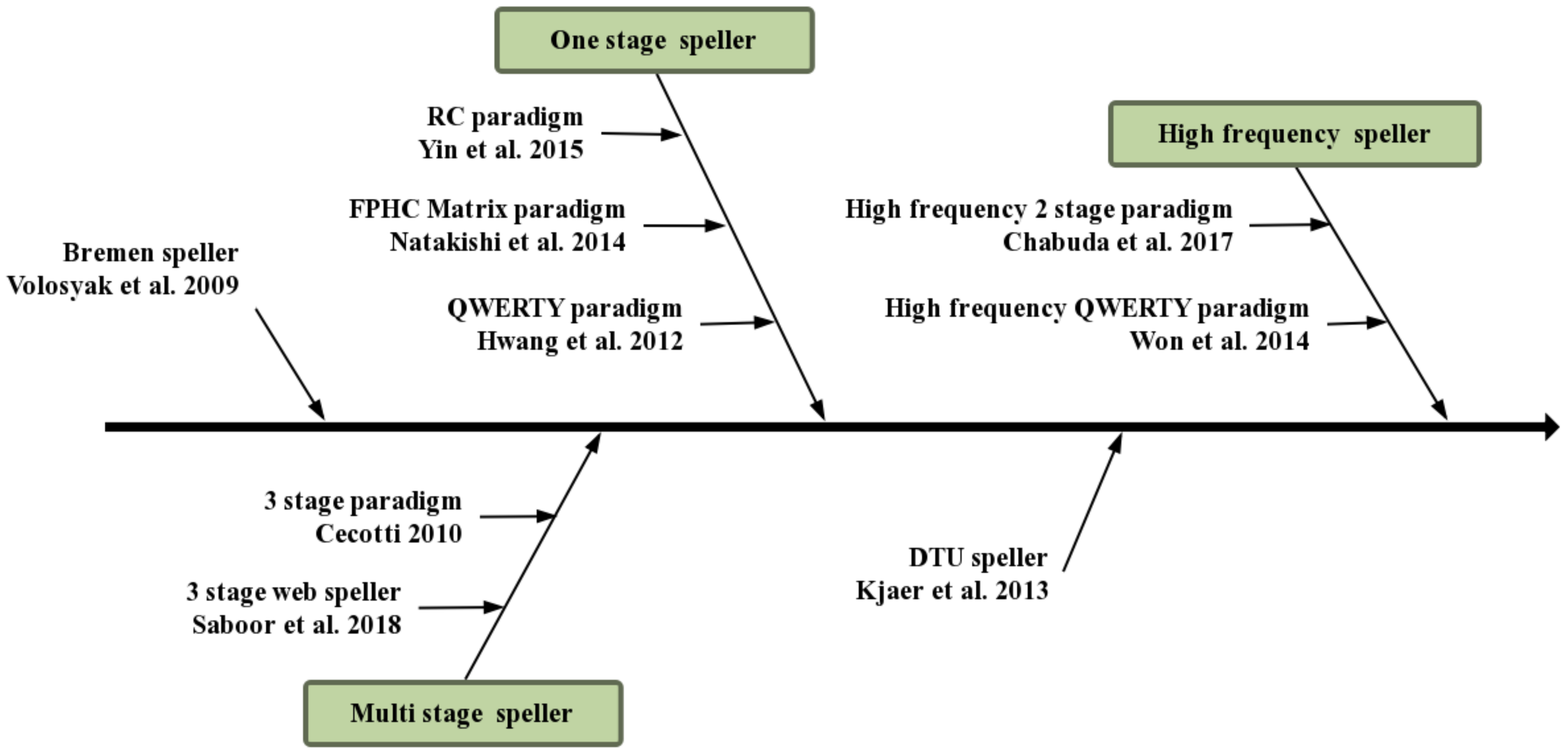
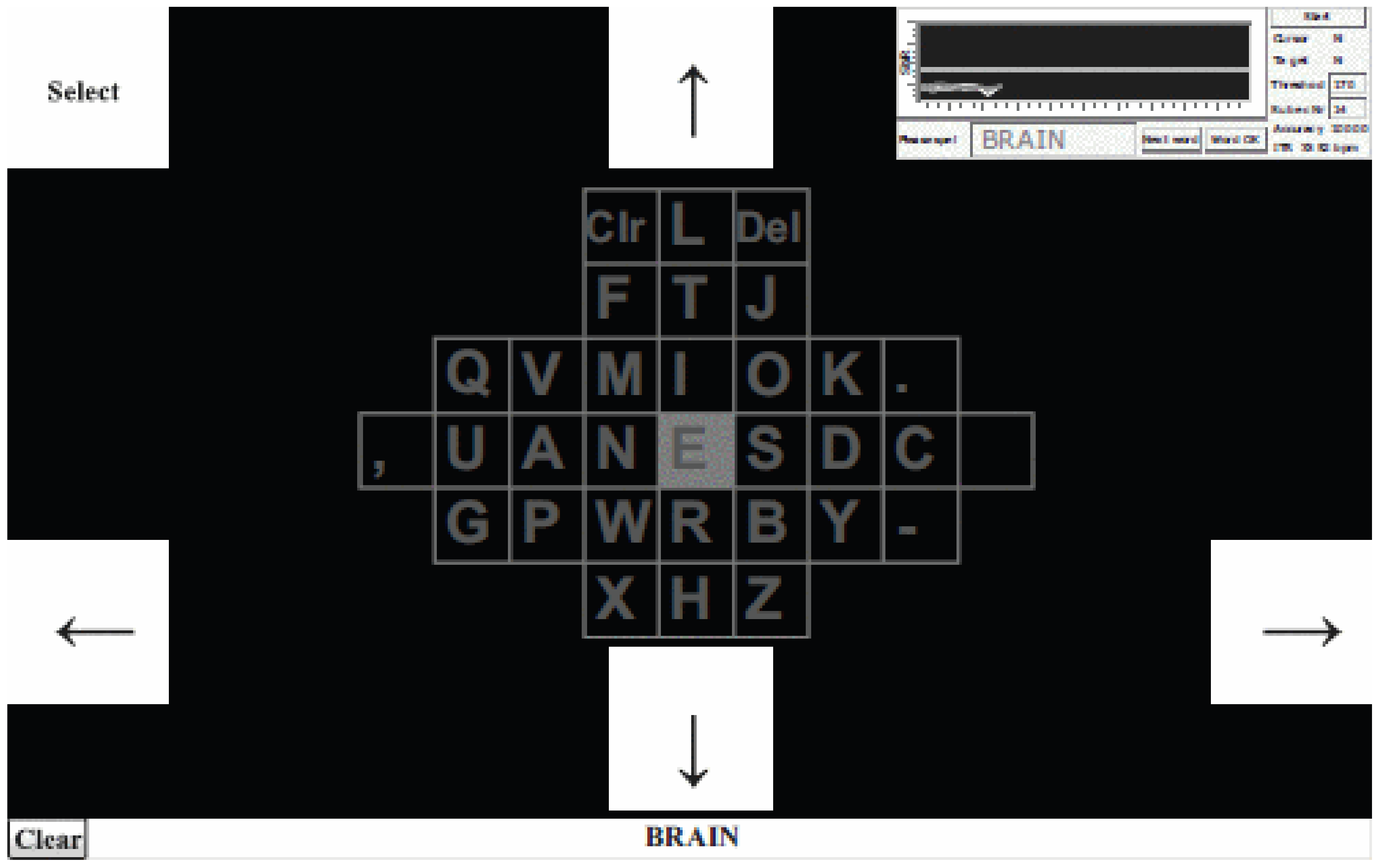

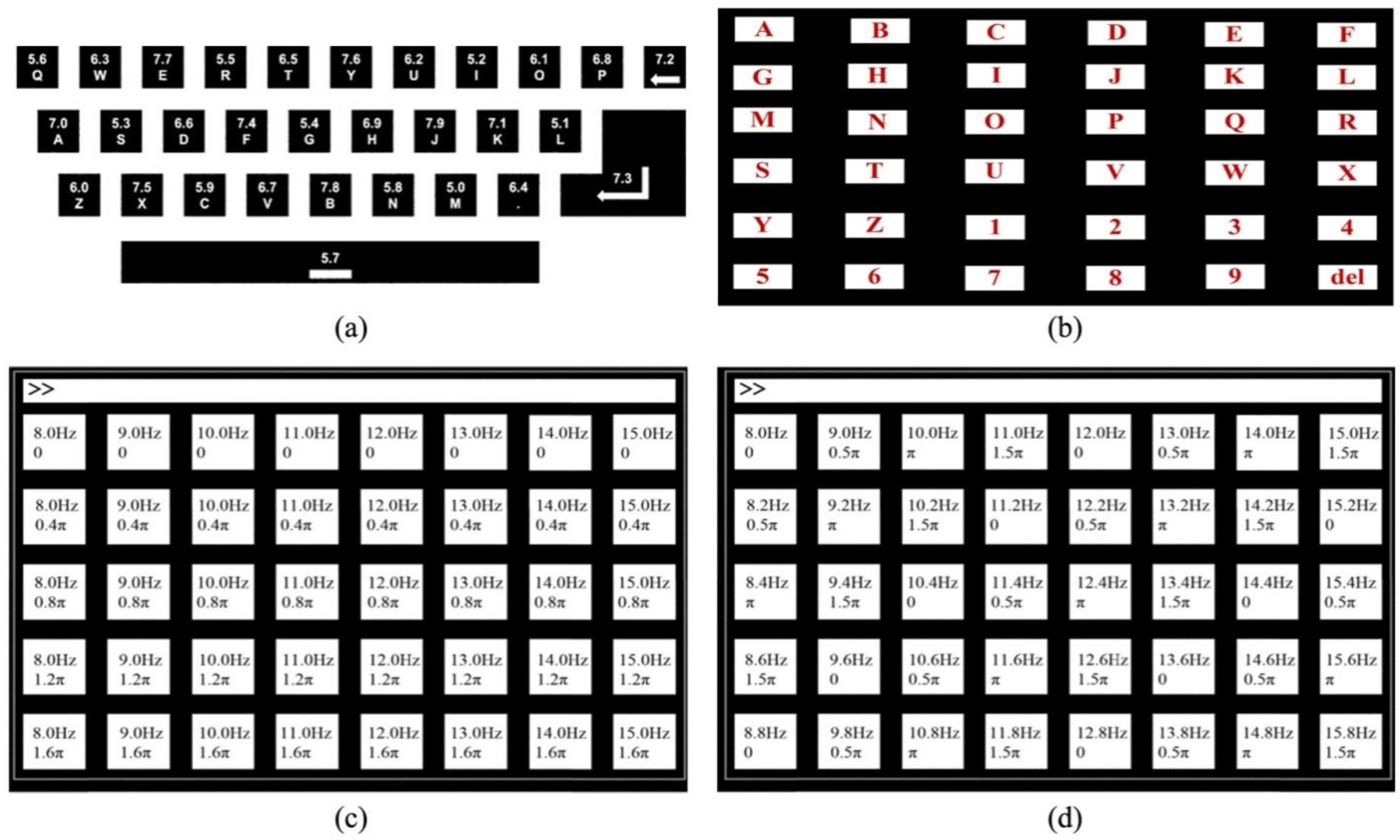
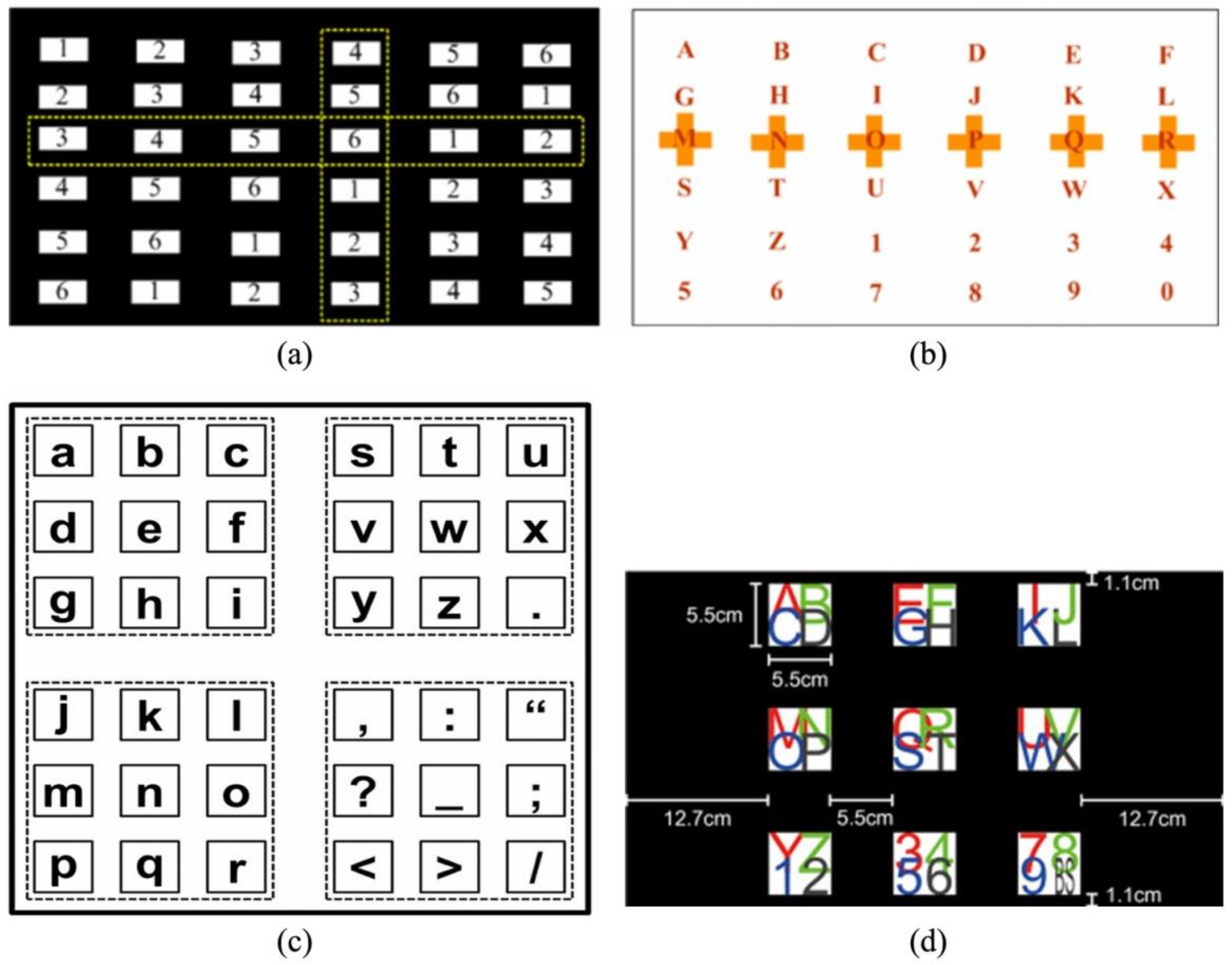
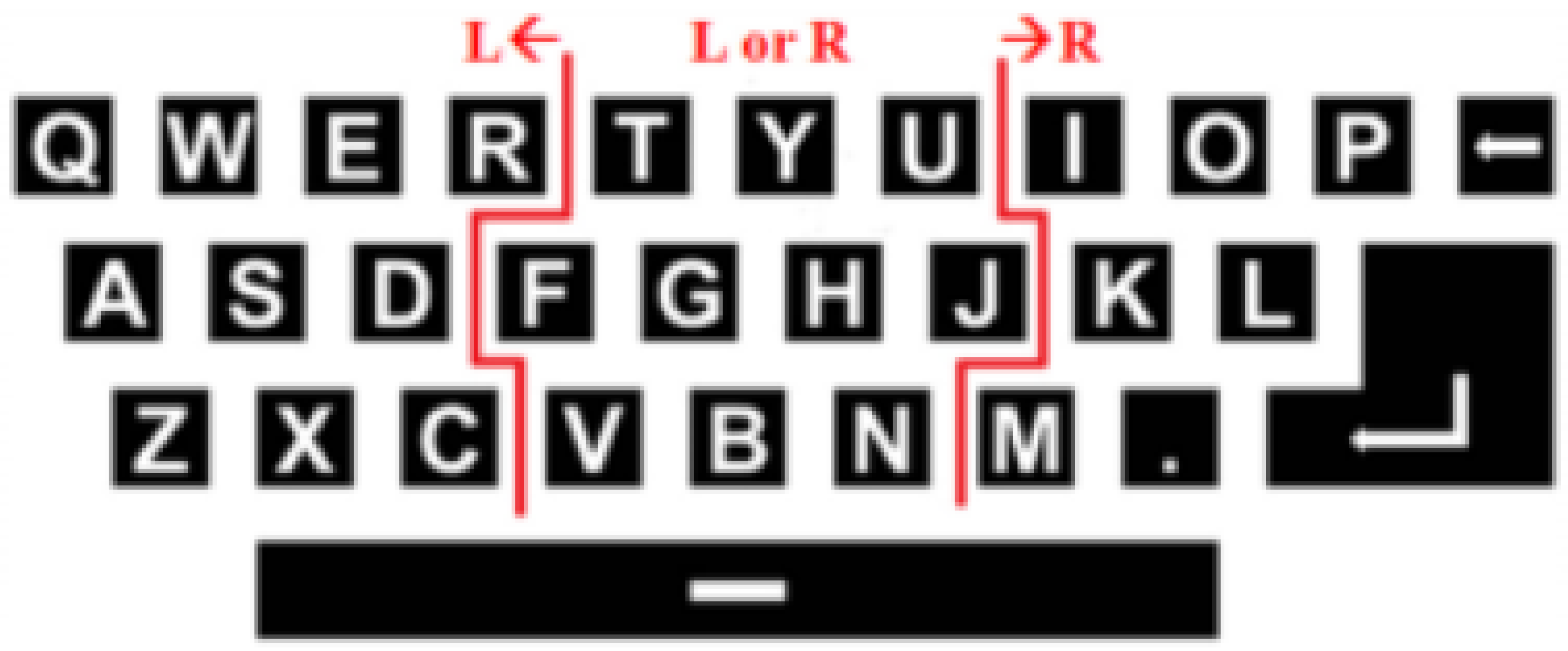
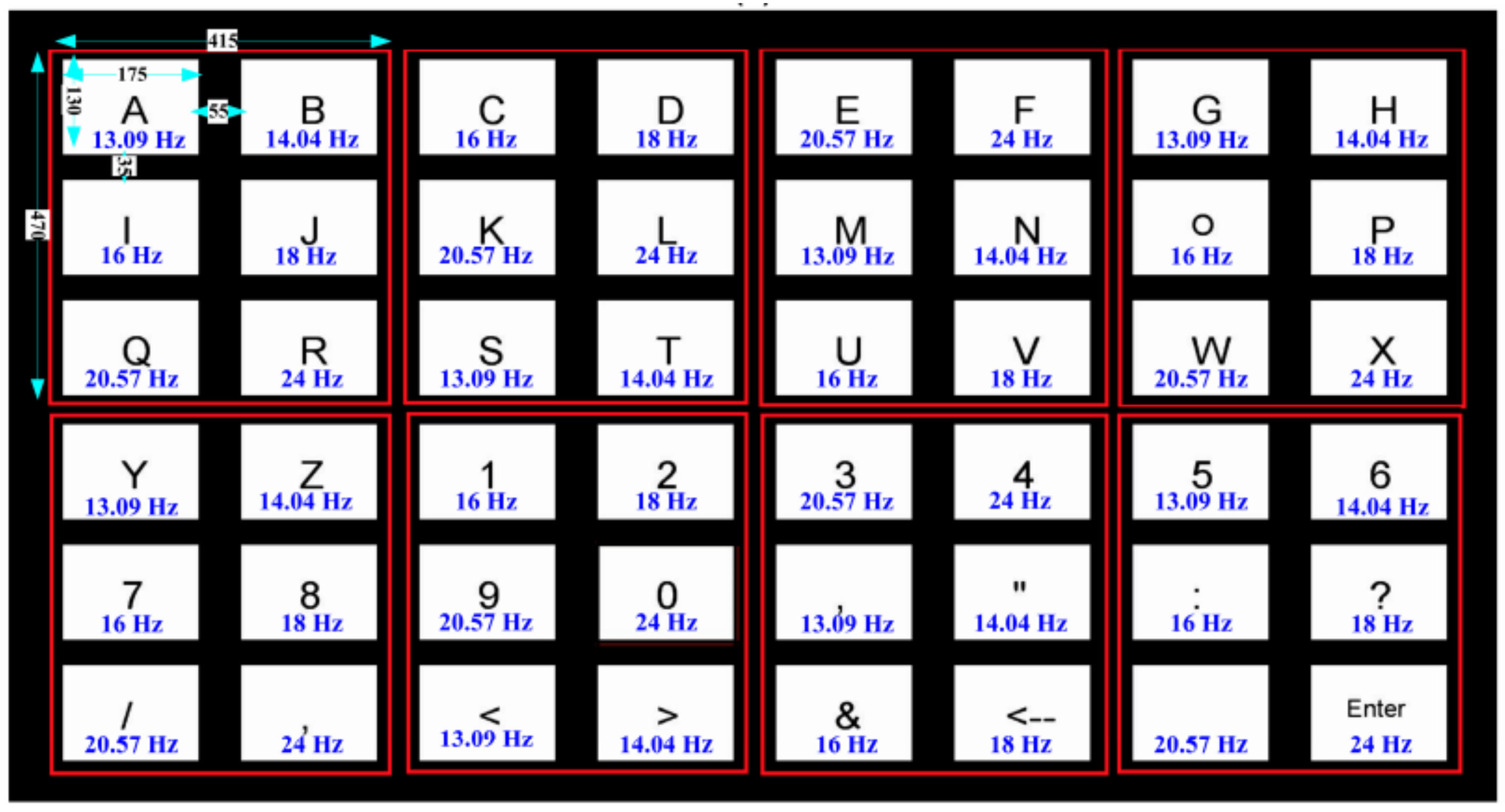
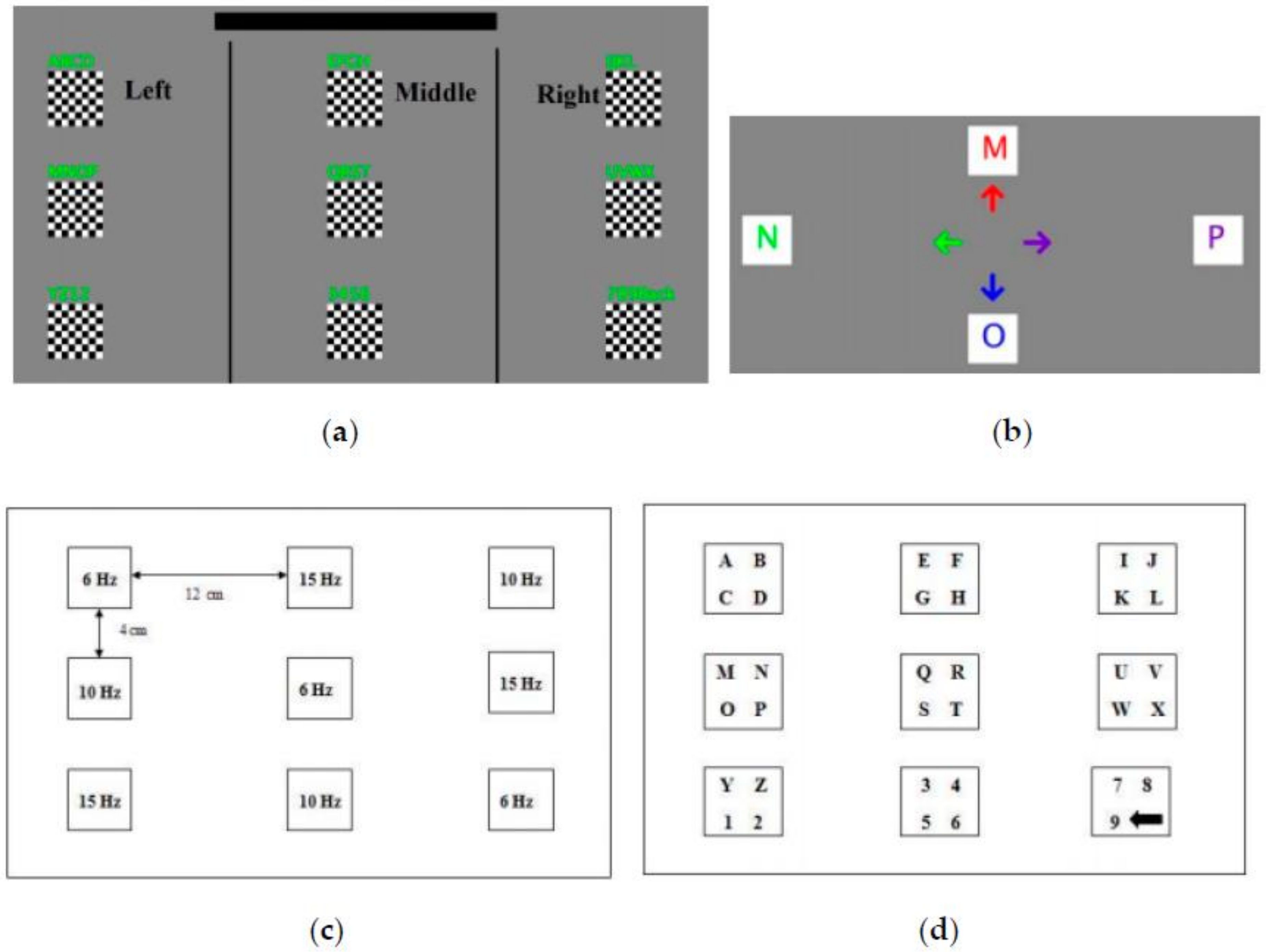
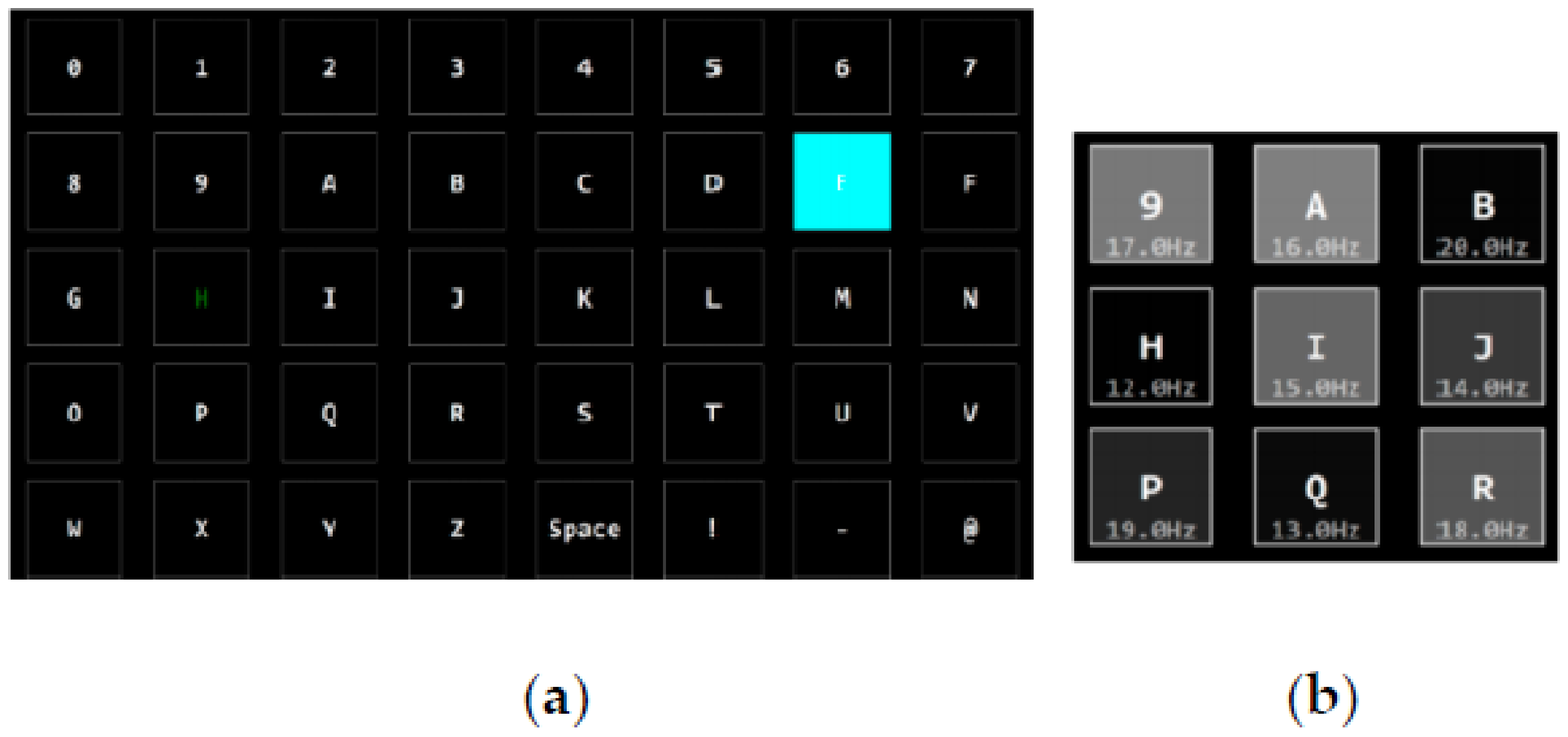

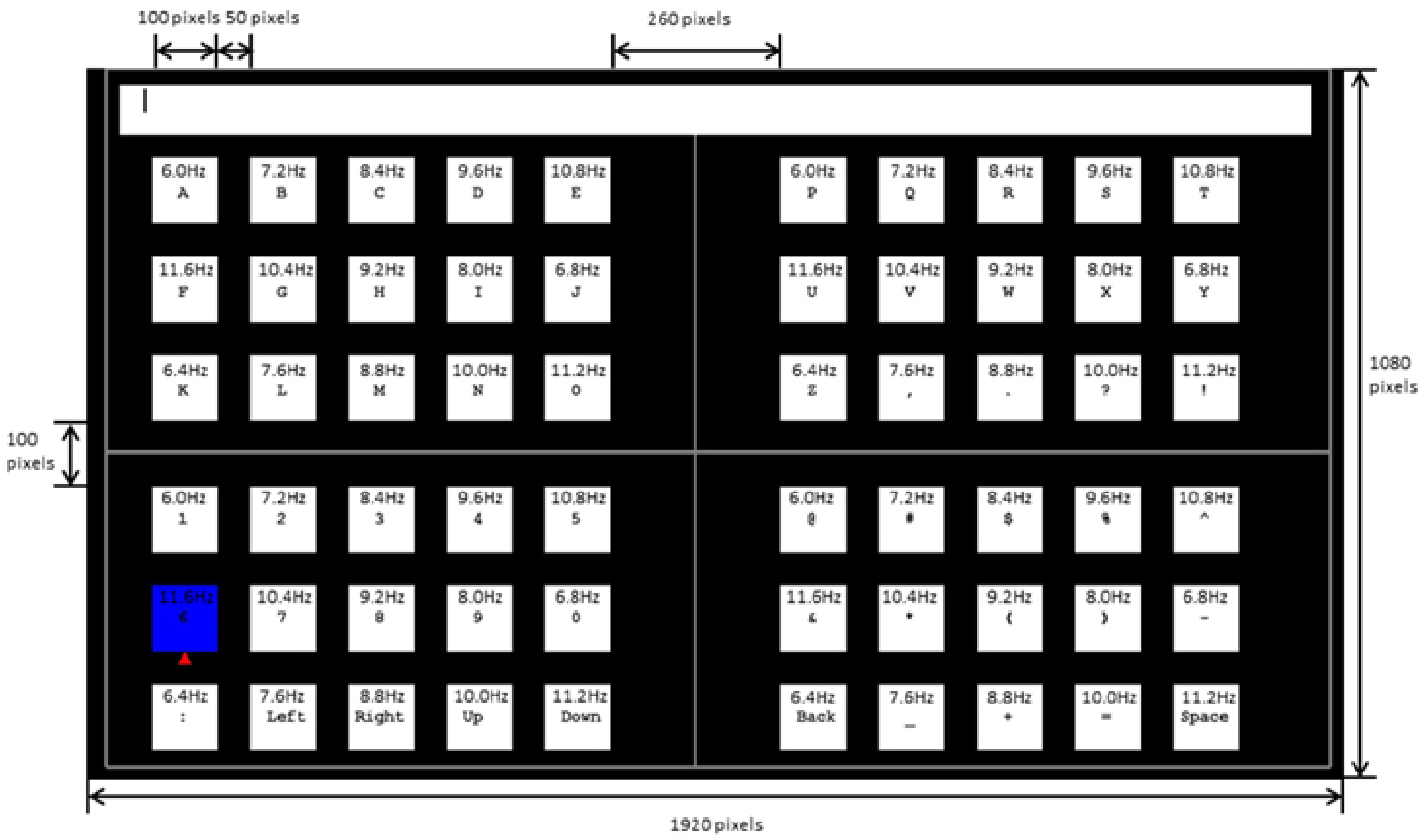
| Reference | SSVEP Detection Method | Paradigm | Number of Commands/Targets | Frequencies of Stimuli (Hz) | Subjects | Accuracy (%) | ITR (bpm) |
|---|---|---|---|---|---|---|---|
| Volosyak et al., 2009 | Principal Component Analysis, (PCA) | Bremen speller | 5 commands 32 targets | 6.67, 7.5, 8.57, 10, 12 | 37 29 healthy | 92.84 | 17.4 |
| Cecotti, 2010 | PCA | Multi-stage speller (3 stages) | 5 commands 27 targets | 6.67, 7.5, 8.57, 7.06, 8 | 8 8 healthy | 92.25 | 37.62 |
| Saboor et al., 2018 | MEC | Multi-stage speller (3 stages) | 4 commands 27 targets | 6, 7.5, 8, 8.5, 9, 9.5, 10 | 10 10 healthy | 94.50 | 12.74 |
| Nguyen et al., 2018 | PodNet | Multi-stage speller (3 stages) | 5 commands 58 targets | 6.67, 7.5, 8.57, 10, 12 | 8 8 healthy | 97.37 | 48.99 |
| Hwang et al., 2012 | Threshold | One-stage speller QWERTY | 30 targets | 5–7.9 (span 0.1) | 10 10 healthy | 87.58 | 40.72 |
| Yin et al., 2015 | CCA-RV (canonical correlation analysis with reducing variation) | One-stage speller RC | 36 targets | 8.18, 8.97, 9.98, 11.23, 12.85, 14.99 | 11 11 healthy | 72.28 | 41.08 (PITR) |
| Nakanishi et al., 2014 | CCA with SSVEP training data | One-stage speller FPHC | 32 targets | 8–15 (span 1) 4 phases 0 0.5π, 1.5π | 13 13 healthy | 91.35 | 166.91 |
| Chen et al., 2014 | Extended CCA | One-stage speller FPHC | 40 targets | 8–15 (span 1) 5 phases 0 0.4π, 0.8π, 1.2π, 1.6π | 6 6 healthy | 89.21 | 172.37 |
| 8–15.8 (span 0.2) 4 phases 0 0.5π, 1.5π | 88.83 | 170.94 | |||||
| Cao et al., 2011 | CCA | One-stage 3 pages | 16 commands 42 targets | 8–15.5 (span 0.5) | 4 4 healthy | 98.78 | 61.64 |
| Kjaer et al., 2013 | Threshold | DTU speller (2 stages + one stage) | 8 commands 49 targets + 6 commands 5 targets | 6, 6.5, 7, 7.5, 8.2, 9.3, 10, 11 | 9 9 healthy | 90.81 | 21.94 |
| Akce et al., 2015 | PSD | Query-based speller | 5 commands 29 targets | 6.67, 7.5, 8.57, 10,12 | 11 11 healthy | 98.5 | 11.93 IGR (cpm) |
| Chabuda et al., 2017 | Time domain comb filter | Multi-stage speller (2 stages) | 8 commands 36 targets | 30–39 (span 1.0) | 15 15 healthy | 89 | 36 |
| Reference | Paradigm | Triggering | Number of Targets | Subjects | Accuracy (%) | ITR (bpm) |
|---|---|---|---|---|---|---|
| Panicker et al., 2011 | One-stage RC | SSVEP +P300 | 36 | 10 10 healthy | 88 | 19.05 |
| Yin et al., 2013 | One-stage RC | SSVEP +P300 | 36 | 12 12 healthy | 93.85 | 56.44 |
| Yin et al., 2015 | One-stage DRC | SSVEP +P300 | 64 | 13 13 healthy | 91.33 | 47.14 |
| One-stage 4D | 95.18 | 50.14 | ||||
| Xu et al., 2014 | One-stage SL | SSVEP-B +P300 | 36 | 11 11 healthy | 87.8 | 54 |
| Chang et al., 2015 | One-stage SL | Dual frequency SSVEP +P300 | 36 | 10 10 healthy | 93 | 31.8 |
| Hwang et al., 2013 | One-stage QWERTY | SSVEP + ET | 30 | 10 10 healthy | 87.58 | 40.72 |
| Mannan et al., 2020 | One-stage matrix | SSVEP +ET | 48 | 20 20 healthy | 90.35 | 190.73 |
| Saravanakumar et al., 2018 | Multi-stage (2 stages) | SSVEP +ET | 36 | 10 10healthy | 90.46 | 65.98 |
| Yao et al., 2018 | One-stage matrix (VR) (dynamic) | SSVEP +ET | 40 | 3 3 healthy | 95.2 | 360.7 |
| Lin et al., 2019 | Multi-stage (2 stages) (dynamic) | SSVEP +ET | 40 | 5 5 healthy | 92.1 | 180.8 |
| Saravanakumar et al., 2019 | One-stage matrix | SSVEP + EOG | 36 | 10 10 healthy | 98.33 | 69.21 |
| Saravanakumar et al., 2020 | Multi-stage (2 stages) | SSVEP (stage 2) + EOG (stage 1) | 36 | 10 10 healthy | 94.16 | 70.99 |
| Lin et al., 2016 | Multi-stage (2 stages) | SSVEP + EMG | 60 | 10 10 healthy | 85.8 | 90.9 |
| Rezeika et al., 2018 | One-stage matrix | SSVEP + EMG | 30 | 8 8 healthy | 93.75 | 31.05 |
Publisher’s Note: MDPI stays neutral with regard to jurisdictional claims in published maps and institutional affiliations. |
© 2021 by the authors. Licensee MDPI, Basel, Switzerland. This article is an open access article distributed under the terms and conditions of the Creative Commons Attribution (CC BY) license (https://creativecommons.org/licenses/by/4.0/).
Share and Cite
Li, M.; He, D.; Li, C.; Qi, S. Brain–Computer Interface Speller Based on Steady-State Visual Evoked Potential: A Review Focusing on the Stimulus Paradigm and Performance. Brain Sci. 2021, 11, 450. https://doi.org/10.3390/brainsci11040450
Li M, He D, Li C, Qi S. Brain–Computer Interface Speller Based on Steady-State Visual Evoked Potential: A Review Focusing on the Stimulus Paradigm and Performance. Brain Sciences. 2021; 11(4):450. https://doi.org/10.3390/brainsci11040450
Chicago/Turabian StyleLi, Minglun, Dianning He, Chen Li, and Shouliang Qi. 2021. "Brain–Computer Interface Speller Based on Steady-State Visual Evoked Potential: A Review Focusing on the Stimulus Paradigm and Performance" Brain Sciences 11, no. 4: 450. https://doi.org/10.3390/brainsci11040450
APA StyleLi, M., He, D., Li, C., & Qi, S. (2021). Brain–Computer Interface Speller Based on Steady-State Visual Evoked Potential: A Review Focusing on the Stimulus Paradigm and Performance. Brain Sciences, 11(4), 450. https://doi.org/10.3390/brainsci11040450






